
MANUFACTURER'S SPECIFICATIONS
AMPLIFIER SECTION. IHF Music Power: 75 watts at 8 ohms; 100 watts at 4 ohms. RMS Power: 27 watts/channel at 8 ohms; 37 watts/channel at 4 ohms. THD: 0.5%. IM Distortion: 0.7%. Power Bandwidth: 5 Hz to 40 kHz.
Frequency Response: Phono, RIAA +1 dB; Aux, 15 Hz to 65 kHz +0,-3 dB. Input Sensitivity: Phono, 2 mV; Aux and Tape Monitor, 180 mV. S/N Ratio (IHF, A): Phono, 70 dB; Aux, 90 dB. Tone Control Range: Bass, +13,-14 dB @ 50 Hz; Treble, ±-10 dB @ 10 kHz. Damping Factor: 70 at 8 ohms.
FM TUNER SECTION. IHF Sensitivity: 1.8 V. THD (Mono): 0.4%. S/N Ratio: 60 dB. Selectivity: 80 dB. Spurious Response Rejection: 75 dB. I.f. Rejection: 100 dB. Image Rejection: 90 dB. AM Suppression: 45 dB. Capture Ratio: 1.5 dB. Stereo Separation (1 kHz): 35 dB.
AM TUNER SECTION. IHF Sensitivity: 15 V. Selectivity: 30 dB. Image Rejection: 65 dB. I.f. Rejection: 70 dB.
GENERAL SPECIFICATIONS
Dimensions: 16 in. W by 5 1/2 in. H by 14 in. D.
Weight: 24 lbs.
Retail Price: $299.95.
Our first introduction to this excellent group of component receivers was in late 1971 when we reviewed Panasonic's then top-of-the-line Model SA-6500 (AUDIO, Nov. 1971). Embodying many of the same electronic features and "dress," the Panasonic Model SA-5800 is a moderate-power, moderately priced receiver with virtually all the control features of its bigger brother left intact. Referring to the photo of the front panel, which is made of heavy, extruded, light-gold anodized aluminum, you will note that rotary controls (as opposed to slide controls on the more expensive model) are used for BASS, TREBLE, BALANCE, and VOLUME. The SPEAKER selector switch, at the upper left of the panel, includes positions for MAIN, REMOTE, MAIN AND REMOTE or PHONES While a separate push-push POWER on-off switch at the lower left, next to the headphone jack, enables you to leave all other control settings where you like them when the set is turned off. The tone controls of the SA-5800, though set by rotary knobs, actually offer more control than the "slide controls" provided on the larger unit, since each control is really a pair of concentric knobs, permitting individual channel adjustment of both bass and treble. A pair of additional push-push switches activate the HIGH-CUT filter and the LOUDNESS circuits while four toggle switches take care of STEREO-MONO mode, FM MUTING, and two tape MONITOR settings. The program selector switch, at the lower right, has positions for PHONO, AUTO FM (Stereo), FM MONO, AM, and AUX. The massive tuning knob at the upper right of the panel--equipped with smooth flywheel action, tunes the illuminated dial pointer across a completely linear FM dial calibration scale. This linear dial scale feature has been commented on before, but it bears repeating. With today's crowded FM dial, it's nice to have as much "spread" between, say, 106 and 108 MHz as you have between 90 and 92 MHz. It makes tuning that much easier and, with Panasonic's accurate calibration, almost eliminates the need for the popular "zero to one hundred" logging scale. (Panasonic includes it anyway!) The pointer, by the way, increases its "glow" when a station has been properly tuned in, but then, of course, there is a center-of-channel tuning meter at the left of the dial for those who wish more definitive assurance of accurate tuning. When the AM mode is selected, the tuning meter needle swings over to the left and becomes a signal strength meter, thus providing the optimum metering function for each of the two radio services. A stereo indicator light, as well as lights which show program source, are arranged above the dial scales and the dial is fully blacked out when power is turned OFF.
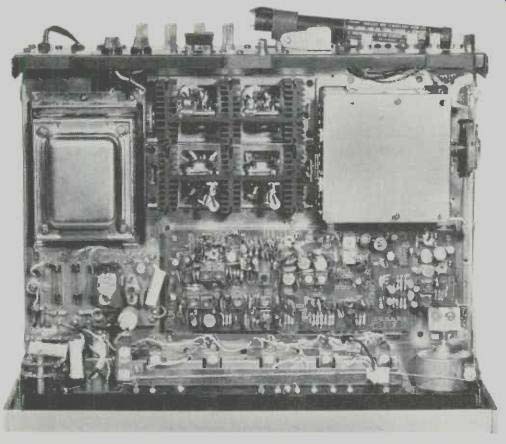
Fig. 1--Internal view.
The rear panel of the SA-5800, shown in Fig. 1, features balanced (300 ohm) and unbalanced (75 ohm) antenna terminals as well as a terminal for connection of an external AM antenna should the self-contained ferrite bar antenna prove inadequate in difficult AM reception areas. The usual input and record output jacks, practically short-proof main and remote speaker terminals, and a pair of convenience a.c. outlets (one switched and one unswitched) are sensibly arranged for easy access. In addition, there are a pair of speaker protection fuses, a center-channel output jack (requiring a power amplifier if it is to be used for a center-fill speaker system), and a pair of circuit jumpers which connect the preamp outputs to the power amplifier inputs. A DIN connector socket is wired in parallel with one of the tape monitor input and output jack pairs, for use with tape recorders equipped with this type of connector. Figure 2 shows the internal chassis layout of this receiver.

Fig. 2--Rear panel.
Construction is modular, employing a sealed front-end and a separate i.f. and multiplex p.c. board. The front-end employs two 4-pole MOS-FET's and a specially constructed variable capacitor which is responsible for the linear FM dial previously described. A three-section tuning capacitor is used in the AM section. The i.f. section includes four differential amplifier stages and six elements of ceramic filters in addition to conventional L-C tuned circuits. The multiplex circuitry is built around a single multi-purpose IC.
The power amplifier circuitry is direct coupled to the loudspeaker terminals and is powered by positive and negative supply voltages. Layout of the unit is well planned, with adequate heat sinking provided for the power output transistors.
Electrical Measurements
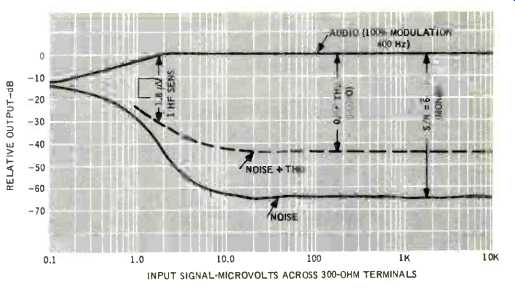
Fig. 3--Mono FM characteristics.
FM monophonic performance is depicted in the graph of Fig. 3. IHF sensitivity turned out to be exactly 1.8 µV, as claimed, while ultimate signal-to-noise ratio exceeded the 60 dB published figure by fully 4 dB, for a reading of 64 dB. THD in mono measured 0.6%, a bit poorer than claimed, but still in the "low distortion" category. Of interest is the quieting attained with a signal input of only 5 microvolts--it measures 58 dB on our unit. The 50 dB quieting figure (which we have come to consider as the truly usable input signal strength) occurs with an input signal strength of just under 3 microvolts.
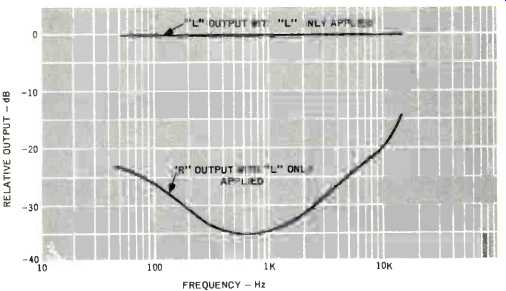
Fig. 4--Stereo FM separation characteristics.
Stereo FM separation is plotted in Fig. 4 and distortion characteristics (at mid frequencies) are shown in Fig. 5. While the THD curve confirms or exceeds published claims (rated distortion is reached at 29 watts per channel with 8 ohm loads as opposed to 27 watts claimed), the IM distortion curve reaches the rated figure at 26 watts just below rated output.
Power bandwidth, shown in Fig. 6, extends from 6 Hz to 40 kHz, just about what is claimed for the unit. In addition to these "full power output" measurements, we plotted harmonic distortion at all audible frequencies for two power output levels--10 watts per channel and 20 watts per channel.
In each case, both channels were driven simultaneously and 8 ohm loads were used. The results are shown in Fig. 7 and, at the 20 watt level, THD approaches rated 0.5% only at the very lowest frequency measured. At the 10 watt level, all measurements at all frequencies were comfortably below the rated THD figure.
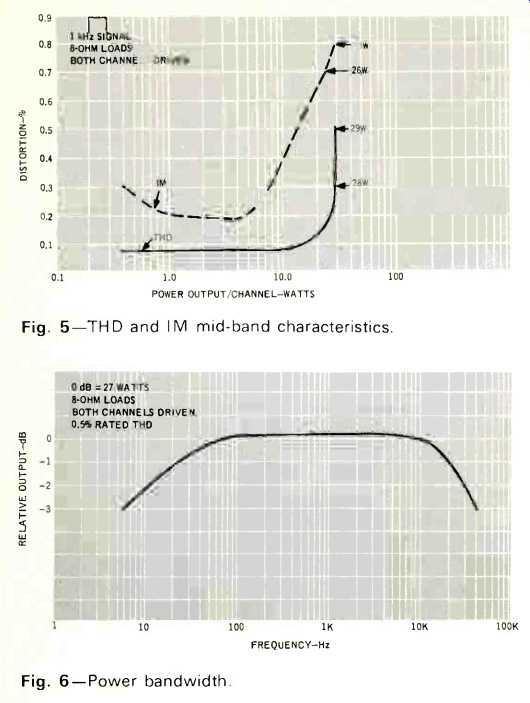
Fig. 5--THD and IM mid-band characteristics. Fig. 6--Power
bandwidth.
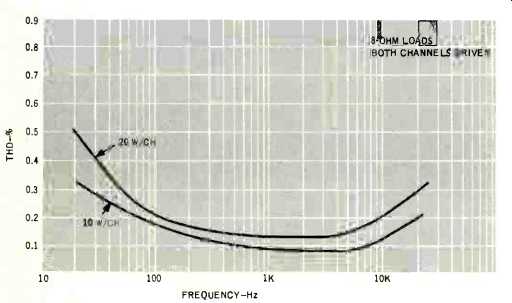
Fig. 7--Distortion vs. frequency at two power levels.
Figure 8 shows the preamplifier control ranges for bass, treble, high frequency filter, and loudness circuits and is seen to conform quite closely to published specifications. Though only one channel's results are shown, both channels were within 1 dB of each other in both tone and filter action. The high frequency filter has a turnover frequency of approximately 5 kHz which makes it useful for noise reduction even though the slope is only 6 dB per octave. All equalization specs for phono inputs were within the 1 dB of the RIAA curve, as specified.

Fig. 8--Tone, filter and loudness control characteristics.
Listening Tests
Operated with medium efficiency speaker systems, the Panasonic SA-5800 had more than enough power to provide a room-filling clean musical program. In fact, two sets of such medium efficiency systems did not noticeably tax its power output capabilities. With really low efficiency types, however, the SA-5800 would have been unhappy with more than a single pair. Our listening room measures about 15 feet by 25 feet and might be classified as "medium" in its absorption characteristics.
The FM section behaved almost exactly like its counterpart in the more expensive Panasonic receiver tested some months ago, so that if you feel that 27 watts per channel is all the power you need in your installation, you need not worry about concomitant "downgrading" of the FM section-there isn't any.
With the muting switch in the ON position we were able to receive some 44 signals acceptably, of which 26 were transmitting stereo programming. Defeating the MUTE circuit raised the number to 49, and of the new five, three were still acceptably free from background noise. This would seem to indicate that perhaps Panasonic should take advantage of its excellent quieting characteristic and re-adjust the muting threshold level to a somewhat lower point (there is no means for the user to perform this adjustment)--say 4 or 5 microvolts instead of the 7 where it is now set.
It should be noted, too, that the AM circuitry of the SA 5800 is not a perfunctory addition. It really sounds noticeably better than a good many AM sections of other receivers we have tested, and when we listened to the one or two stations in our area which profess to transmit AM with increased frequency response, we could actually hear the difference.
While no distortion specification is offered in the published specifications, we were so impressed with this "rarity" that we took the set back to our labs after the listening tests and were pleased to find that THD at 30% AM modulation was less than 1%--quite an achievement for the so-called "lo-fi" medium.
In summary, then, the Panasonic SA-5800 should make an excellent "electronic heart" of a stereo system in which super-high power is not required and where budgets are modest compared to the desire for near-perfection in performance.
--Len Feldman
-----------
(Audio magazine, Aug. 1972)
Also see:
Panasonic RS-736US Stereo Tape Deck (Oct. 1972)
Sony Model STR-7065 Stereo FM/AM Receiver (Nov. 1973)
Onkyo Model TX-2500-II AM/FM Stereo Receiver (Equip. Profile, Feb. 1979)
Tandberg 3080A FM Receiver (July 1989)
= = = =